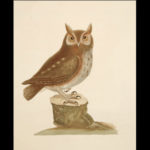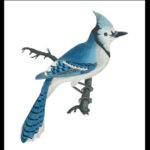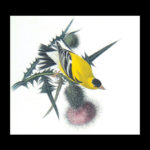The Great Smoky Mountains National Park is a premier place for birds. The crest of the Smokies towers nearly a mile above the foothills, creating a range in elevations and a variety of topographies that provide for a diversity of habitats and microclimates for birds. From the high, exposed peaks to the warmer, sheltered lowlands, some 240 species of birds have been found in the park. Sixty species are year-round residents; and nearly 120 species breed in the park, including 52 species from the neo-tropics (a biogeographic region that includes South America, the West Indies, and tropical North America). Many other species use the park as an important stopover and foraging area during their semiannual migration.
In commemoration of the seventy-fifth anniversary of the Great Smoky Mountains National Park, the McClung Museum has chosen from its collections a selection of hand-colored copper plate engravings and lithographs by Mark Catesby, Alexander Wilson, and John James Audubon. These three early naturalists and artists traveled widely in the southeastern United States, collecting, naming, and illustrating plants and animals they encountered. In this exhibit of their artwork, many of the bird species that can be found in the Great Smoky Mountains National Park are presented.
Mark Catesby exhibited a keen interest in natural history growing up in Suffolk, England. An opportunity to visit his sister in Virginia in 1712 brought the young man into contact with the rich flora and fauna of the New World. Returning to England in 1719, Catesby acquired patronage and support, and was persuaded to take on a natural history of America that had been started by John Lawson before his death in 1711. Catesby returned to South Carolina in 1722 and, for the next three years, made notes and drawings and assembled an enormous collection of plants and animals from the Southeast.
Returning to England in 1726, Catesby set about assembling and publishing the results of his travels, the first volume being published in 1731. When finished, Catesby’s Natural History of Carolina, Florida, and the Bahama Islands included 220 hand-colored engravings, illustrating 109 birds, thirty-three amphibians and reptiles, forty-six fishes, thirty-one insects, nine quadrupeds, and 171 plants.
Catesby’s Natural History is a pioneering work in scientific illustration and, until the time of Audubon a hundred years later, the best illustrative treatment of the flora and fauna of North America. Although his achievements have to a degree been obscured by Audubon and other illustrators of the nineteenth century, Catesby rightly has been recognized as the founder of American ornithology and appropriately designated the “Colonial Audubon.”
Alexander Wilson is considered by many to be the “Father of American Ornithology.” A close friend and student of William Bartram, he produced from 1808 to 1814 the nine-volume American Ornithology, with 320 hand-colored engravings representing 262 species (the last part of Volume 8 and all of Volume 9 were produced after his death by George Ord). Wilson met John James Audubon in 1810, and it was Wilson, already the leading authority on birds of North America, who probably inspired young Audubon to embark on his own monumental publication. Unfortunately, Wilson’s untimely death at forty-seven and his close juxtaposition in point of time to Audubon made him less known. Although Audubon’s paintings surpass Wilson’s, Wilson’s text is regarded as far more valuable.
The name “Audubon” has become synonymous with birds and their protection. No bird painter before or since has singlehandedly achieved so much, overcoming the challenges of the wilderness and the difficulties of meeting the expenses to fulfill his dream. John James Audubon set standards of artistry against which later painters are inevitably measured, irrespective of differences in media or goal.
From 1820 to 1838, Audubon explored North America from Labrador to the Florida Keys and west to Texas and the northern Great Plains. Frustrated that he was never able to reach the Rockies or the Pacific, he nevertheless painted nearly 500 of the approximately 650 bird species regularly found in North America. Audubon sought to know the birds in their natural habitats; his drawings usually were based on long hours of observation, as well as specimens in the hand—often innovatively mounted on wires and traced on graph paper so he could depict birds in more lifelike positions.
The Birds of America (1827–38) ultimately consisted of 435 plates engraved in aquatint and hand-colored by Robert Havell; these contain 1,065 life-sized figures of 489 supposedly distinct species. Between 1840 and 1844, The Birds of America was published in a smaller size (royal octavo) that was lithographed and hand-colored by J. T. Bowen of Philadelphia; prints in this exhibition come from the royal octavo edition. The edition differed from the previous double elephant folio size in grouping the birds by species and devoting a separate plate to each species.
- Screech Owl, 1731-43, Mark Catesby, Hand-colored etching
- Bluejay
- Bobwhite
- American goldfinch
Curator: Gerald R. Dinkins
With generous support from First Tennessee Foundation and Wildcat Cove Foundation.




